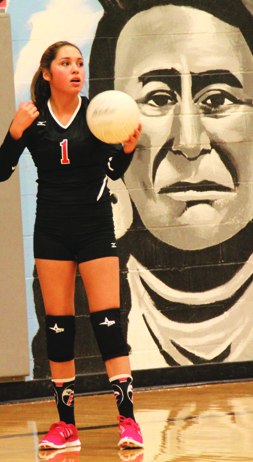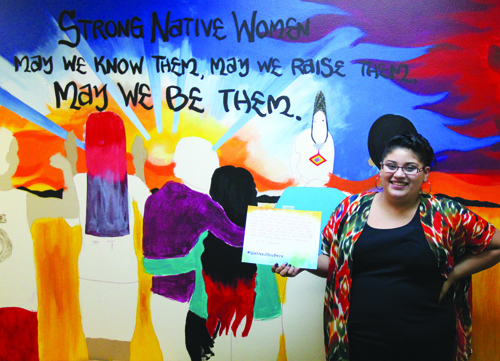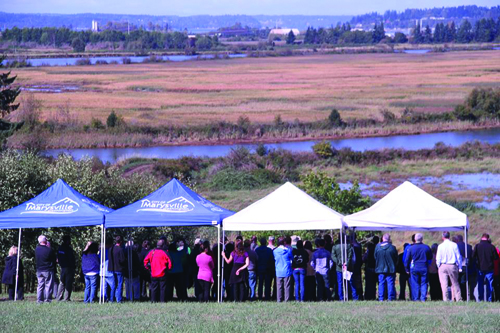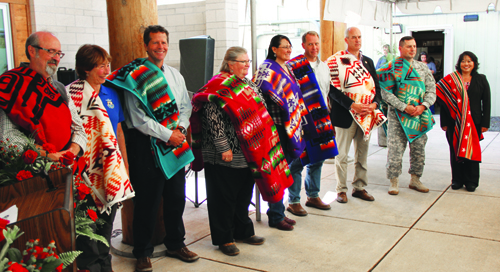The walk will begin at the Tulalip Health Clinic at 5:oo p.m.
For more information contact Family Haven, 360.716.4401 or 360.716.4402
syəcəb
Click on the link below to download the September 23, 2015 issue of the Tulalip syəcəb newspaper:
By Niki Cleary, Tulalip News
It’s a nightmare. Whether it happens to you or someone you love, or just someone in your community, it is a trauma with vast ripple effects. Rape. Sexual violence. Child molestation. Just naming the crime is uncomfortable, scary, traumatizing. Imagine if it happened to you, to your best friend or sibling, and it’s every parent’s worst nightmare to think it could happen to your child.
“Victims might hold onto an assault for years without saying anything,” said Tulalip Chairman Mel Sheldon. “In the past, when they found the courage, or the right situation came up where they could talk about it, the statute of limitations may have passed. There was no justice for them. This is about sending a message to those that were victimized, letting them know that we care and from this day forward there will be justice no matter when the crime happened.”
According to the Department of Justice National Crime Victimization survey 284,350 people were victims of rape or sexual assault nationally. This doesn’t include domestic violence or intimate partner violence, which often includes a sexual assault component.
“We know Native American women are three times more likely to be sexually assaulted,” said Tulalip Prosecutor Brian Kilgore. “It’s an epidemic and it drives a lot of the trauma and grief behind the drug epidemic.”
Only a fraction of sexual assaults are ever reported and fewer still are prosecuted. The reasons why are far from simple. They run the gamut from cultural norms to the physical, financial and psychological pros and cons of reporting. Particularly, since the majority of sexual assaults are committed by someone known, or related to the victim.
A few of the lifelong effects of sexual assault include post-traumatic stress disorder, inability to form healthy attachments, sexual dysfunction, depression and anxiety. This is also further complicated by the reactions of those close to the victim when the victim discloses the crime. The fear of losing their support systems, or worse, being shunned or blamed for the assault, often stops victims in their tracks.
“This is about sending a message to those that were victimized, letting them know that we care and from this day forward there will be justice no matter when the crime happened.”
– Mel Sheldon, Tulalip Tribes Chairman
“If you have 100 sexual assault victims, maybe 10 or 15 will get reported,” explained Aaron Verba, the Domestic Violence and Sexual Assault Investigator for the Tulalip Prosecutor’s Office. “You might file three and then when it comes to a guilty verdict, maybe you’re down to one. It really comes down to the cost for the victim,” he continued. “There’s a 99 percent chance that you were victimized by someone you know or are related to.”
Because the perpetrator is often part of the community, peers and family may be unwilling to believe the crime happened. In many cases not believing the victim is a form of self-protection, Aaron described. Families don’t want to see another family member as an offender.
“Everyone is victimized,” he said. “For the family, if they support the victim sometimes they have to admit, ‘I believe this bad thing happened to you and I may have unknowingly been involved in the grooming process.’ The family has to decide whether it’s safer for them to support the victim or the perpetrator.”
Oftentimes, it’s easier to simply deny that the crime happened, to blame circumstances or even blame the victim. Jade Carela, of the Child Advocacy Center.
“Why don’t they come forward?” she asked. “As a community member, I feel like the community support isn’t there yet. We have sex predators in our community that hold high positions or spiritual positions in our tribe. Victims have to wonder, ‘Why would I come out in a community that still holds these people up? I’m not going to get support.’ In the past when they were ready, the statute of limitations may have been up, and then it was too late.”
“It’s especially hard to disclose if a victim has seen another victim disclose and it went badly for them. Sometimes people justcarry that trauma around with them,” Aaron continued. “It’s a conversation we have with every victim that walks in here. Or they may be thinking I’m going to put this person away for the rest of his life, and you have to have an honest and frank conversation about the fact that we may not get 40 years, or even 30. This person may be back in the community in one year.”
Particularly in Native American communities, after the perpetrator serves time, community will be looking to reintegrate the person into everyday life. That means that the victim will likely encounter the perpetrator at community events, family events and everyday activities like going to the grocery store.
“When you sit down and tell people realistically what is going to happen, sometimes they change their mind,” said Aaron.
With all of the obstacles and potential fallout surrounding sexual abuse, there are just as many positive reasons to disclose a sex crime.
Brian explained that most rapists have a history of sex crimes, and unless they’re prosecuted, a future. Making sure that a perpetrator doesn’t hurt someone else is a huge incentive for some victims.
“Rape kits are expensive to test,” said Brian. “The State of Ohio had thousands of untested rape kits sitting on a shelf and they paid to have them all tested. When they did they found a pattern because most rapists are serial rapists. It’s not a comfortable thing to say, ‘I was raped,’ but there’s a good chance if they’ve done it to you, they’ve done it to other people. The only way to stop them is to shine some daylight on it.”
Removing the statute of limitations on sex crimes isn’t just an empty political move, said Jade, it’s a step towards justice, healing for victims and an overall healthier community.
“As a community, we can show these victims that we love them by not being secretive about this. We need to educate our children, and come forward. Know that from here forward, whenever you are ready, we can still prosecute the crimes that happened to you.
“We always talk about the drug epidemic,” she continued. “Drugs are a symptom, they’re not the cause. The root cause is that when these drug addicts were little kids, things happened to them. If we want to eradicate drug use on the reservation, what we need to do now is keep our children safe.”
Aaron agreed, “There’s an incredibly high correlation between drug use and trauma. If you poll all the people who come through our court for drug offense, I’m guessing that 99.99% of them would have some sort of emotional abuse, neglect, physical abuse, or sexual abuse. Ultimately there’s a reason that you use drugs to change your reality, usually it’s because your reality sucks.”
Last, both Jade and Aaron agreed, disclosure is about healing.
“The women coming out now were children when this happened to them,” Jade said. “Hopefully, now they’ll feel safe enough to tell the reality about what happened to them so that they can get help. So that they don’t pass that on to their children.”
Aaron pointed to the new law as a sign of the changing times. But family support is going to be even more valuable.
“The important thing is how we support a victim,” he said. “When they disclose, they need to know they’ll be believed and someone will do something about it. The big thing about disclosure is that’s when you start healing. You can’t truly heal a wound until you take care of it, you can cover it up, you can ignore it or pretend it didn’t happen, but you can’t truly heal.”
Aaron also pointed out that sexual assault leaves scars that can take generations to heal.
“I heard once that it takes seven generations for sexual abuse to get out of a family,” he said. “That’s if the first person actually gets treatment, resolves issues and gets back to a somewhat healthy way. That person is still going to pass some of it on. You can’t not pass your life experiences on to your children, whether you know you’re doing it or not. We have people who have kept that stuff hidden for 30 or 40 years. The people on this reservation are still dealing with the effects of sexual abuse in boarding schools.”
This resolution is not retroactive. If the statute of limitations has already expired, the crime may not be prosecuted in Tulalip Court. However, Brian explained, it’s still worthwhile to report it.
“If you have DNA evidence, the federal statute of limitations runs from when you test the evidence,” he said. “For a lot of folks, the police may have a current file on the perpetrator, and any information will help them in their investigation. We can never promise that a case is going to be prosecutable, but we don’t know if it’s never reported.”
If you were the victim or witness of a sexual assault, or any crime, the first step is to call the police, regardless of how much time has passed. In emergencies always call 911. For non-emergencies you can reach the Tulalip Police Department at 360-716-4608.
By Micheal Rios, Tulalip News
On Tuesday, September 15, the Tulalip Heritage Lady Hawks hosted the Lopez Island Lobos at the Francy Sheldon gymnasium. It was the first game of the 2015-2016 volleyball season and home opener for the Lady Hawks. Coming off a very disappointing season last year, that saw them win only one set and zero matches, the Lady Hawks were excited to start fresh.
Unfortunately, there were some behind the scenes issues with their previous coach, and for reasons unknown she was replaced last minute by Tulalip Heritage Athletic Director, Tina Brown. Coach Tina spent the last couple weeks with the Lady Hawks going over volleyball basics and focusing on conditioning.
In the 1st set the Lady Hawks would fall 16-25, followed shortly thereafter by a quick 2nd set 9-25. However, in the 3rd set the Lady Hawks showed signs of their dedication to teamwork as they fought and scraped for every point they could muster. After falling behind 7-13, the Lady Hawks rallied to take a 15-14 lead behind the serving of #10 Keryn Parks and #13 Jaylin Rivera. The Lopez Island Lobos wouldn’t be denied and went on to win the 3rd and final set 25-20.
Losing the match 0-3 was a bummer, but captain #1 Myrna Redleaf was upbeat after the loss, saying “I thought we did really well compared to last year, especially going against our rivals from Lopez Island. I feel we did really well for our first match of the year. We have a lot of new girls playing this year, and we’re all still getting used to playing with each other and learning each other’s tendencies. We were really nervous in the first couple sets, but in the last set we relaxed and just had fun and our play was better.”

Going forward, Myrna says the team will look to improve their communication most of all. The Lady Hawks take on Highland Christion on Friday, September 18. It’s a home game and starts at 5:00 p.m.

by Micheal Rios, Tulalip News
When it comes to suicide prevention, every day matters. In honor of World Suicide Prevention Month (September), the Tulalip Tribes thank those that work in our community and take action every day to bring suicide prevention services and awareness practices to our tight-knit community.
World Suicide Prevention Day, which first started in 2003, is recognized annually on September 10 and aims to:
Tulalip tribal member Jo-E-Dee Fryberg is only 17 years-old, yet she has found a passion for helping her people. She has focused on suicide prevention by helping youth in her Tulalip community and other communities succeed by finding hope where hope doesn’t seem to exist.
Jo-E-Dee is one of three We R Native youth ambassadors reaching out to young Natives by promoting World Suicide Prevention Month in a YouTube video featuring Native youth who are survivors of suicide or suicide attempts. Their message: #WeNeedYouHere.
“We’ve been losing a lot of kids to suicide. It’s something that never stops. But I’m hoping that with this generation we can finally stand up, talk to someone, and seek help for what we’re feeling, instead of letting this cycle of youth suicide continue,” says Jo-E-Dee. “The #WeNeedYouHere message, it speaks to people my age and from communities like mine.”
We R Native is a multimedia health resource for Native teens and young adults run by the Northwest Portland Area Indian Health Board. They are a comprehensive health resource for Native youth, by Native youth, providing content and stories about the topics that matter most to them. We R Native strives to promote holistic health and positive growth in our local communities and nation at large.
Native youth ambassadors from across the nation began spreading the message for suicide prevention and awareness over the summer, “helping to spread positive vibes and create positive change in their local communities,” We R Native said in a press release.
Creating awareness that suicide can be prevented is their first project. To increase the visibility of their campaign they created the hashtag #WeNeedYouHere, and individually they are speaking out.
Suicide has personally affected ambassador Jo-E-Dee. She shares how her involvement in canoe journeys and pow-wows helped her cope with her brother’s death, and how she feels personally invested in spreading the #WeNeedYouHere message.
“My brother [Clinton “Crazy Wolf” Fryberg] committed suicide in 2010. His death changed me forever. I became suicidal and didn’t know how to deal with those thoughts and feelings. I didn’t know how to talk about it,” recalls Jo-E-Dee. “Those of us who struggle with suicidal thoughts and feelings, we don’t really understand what it is we’re going through. I went to treatment, and through therapy learned how to talk about what I was feeling. I learned why I was feeling suicidal and how to find my way back to living a good life.”
This challenge of suicide prevention hits home for a lot of us. Suicide is a very tough issue, but addressing the tough issues and speaking openly to let our people know that we care is crucial to the healing process.
“Here’s some things I can do if I’m having suicidal thoughts: call someone and flat out tell them ‘I’m feeling suicidal and I’m scared. I don’t know what to do’,” says Joe-E-Dee. “Going to church and staying invested in our cultural activities warms our hearts, you know, like you feel happy when go and it makes you want to keep on going back and doing what you are doing. I felt hopeless before, and if you feel hopeless this is what you need to know: there’s always room for something new and it’s never too late to start something good.”
If you need help, or to give help, call 1-800-273-TALK (8255), or text START to 741741 to chat via text.
According to the World Health Organization, nearly 3,000 people on average commit suicide daily. About one million people die by suicide each year. Suicide rates are at an all-time high for U.S. military veterans. In addition, for every person who commits suicide, 20 or more others attempt to end their lives. What’s obvious from the World Health Organization statistics is that suicide does not discriminate upon race, age, or gender. It is a social issue that plagues everyone, whether directly or indirectly.
The effects of suicide are not limited to those who die. Suicide is a serious public health problem that has shattered the lives of millions of people, families, and communities nationwide. We can all take action to reduce its toll. A variety of strategies are available for individuals and organizations across the United States to help prevent suicide.
On the local, tribal level the Tulalip Tribes have been hard at work on a Suicide Prevention Plan that aims to stop Tribal member suicides, based on the belief that suicide is preventable in our community.
Although suicides occur everywhere in the world, Native Americans are disproportionately affected by suicide and the lasting impact it has on our tight-knit communities. In Tulalip, we recognize the role that historical trauma plays in the mental health of our people. The events of history cannot be changed and the effects of trauma now exist in our bodies and the struggle for healthy coping skills and mental resiliency is a challenge. This plan is vital in our journey to healing; we know that every life is important and we are dedicated to educating our people and preventing unnecessary death.
Tulalip community members who are interested in receiving assistance with mental wellness should call the Family Services main number to schedule an intake for individual or family counseling: 360-716-4400 (18 and over) or 360-716-3284 (under 18).
Warning signs of suicidal behavior
Everyone can play a role in preventing suicide by being aware of the warning signs of suicidal behaviors:
What you can do
If you believe someone is at risk of suicide:
Contact Micheal Rios, mrios@tulaliptribes-nsn.gov

By Micheal Rios, Tulalip News
The Qwuloolt Estuary Restoration Project took 20 years to complete. The finish line was crossed on Friday, August 28, when massive excavators and bulldozers breached a levee and reopened 354-acres of historic wetlands to threatened Puget Sound chinook salmon. The levee breach culminated what has been recognized as the state’s second-largest ever estuary restoration project.
“This is a great, great day. It’s been a long time coming,” says Kurt Nelson, Tulalip Tribes’ Environmental Department Manager, at the September 2 levee breach celebration. “I’ve been on this project for 11 years and there have been many challenges and hurdles, but we’ve gotten through them all. What we have now is a 354-acre estuary wetland complex that saw its first tidal flows in 100 years last Friday [August 28].
“If you watch the live-stream webcam in fast motion, you’ll notice it’s almost like this site is breathing. The estuary is flooding and draining, flooding and draining with tidal waters, like a lung does with oxygen. It’s a nice comparison to bringing some life back to an isolated floodplain that hadn’t seen that kind of life in a longtime.”
The Qwuloolt Estuary Restoration Project (QERR) is a partnership of tribal, city, state and federal agencies aimed at restoring a critical tidal wetland in the Snohomish River estuary. The Qwuloolt Estuary is located within the Snohomish River floodplain approximately three miles upstream from its outlet to Puget Sound and within the Marysville City limits. The name, Qwuloolt, is a Lushootseed word meaning “salt marsh”.
Historically, the area was a tidal marsh and forest scrub-shrub habitat, interlaced by tidal channels, mudflats and streams. However, because of its rich delta soil, early settlers diked, drained and began using the land for cattle and dairy farming. The levees they established along Ebey Slough, as well as the drainage channels and tide gates, effectively killed the estuary by preventing the salt water from Puget Sound from mixing with the fresh water from Jones and Allen Creeks.
For the past 100 years the estuary was cut off from its connection with the tidal waters and denied the ability to act as a restorative habitat for wild-run chinook salmon and other native fish, such as coho and bull trout. Through the cooperation of its many partners, this project has returned the historic and natural influences of the rivers and tides to the Qwuloolt.
The purpose of the project is to restore the Qwuloolt Estuary to historic natural conditions, while also mitigating some of the damage caused by the now defunct Tulalip Landfill on Ebey Island’s northwest edge. The former 145-acre landfill was operated on Tulalip Reservation land by Seattle Disposal Co. from 1964 to 1979 and become a Superfund site (polluted locations requiring a long-term response to clean up hazardous material contaminations) in 1995, before being cleaned up and capped in 2000.
Qwuloolt will provide critical habitat for threatened Puget Sound chinook and other salmon, as well as for waterfowl and migratory birds. Native habitat and functioning tidal marsh ecosystem were lost when the estuary was diked and cut off from tidal influence. This project will restore tidal flows to the historic estuary and promote: Chinook, bull trout, steelhead, coho and cutthroat rearing habitat, salmon access to greater Allen Creek, migratory and resident bird habitat, water quality improvements, Native vegetation growth and restoration, and natural channel formation.
Trying to recover these critical estuary habits are crucial to migrating juvenile salmon for the salmon recovery effort in the Snohomish region. The Qwuloolt Estuary can now, once again, provide food and refuge for those fish. The intent of the project is to increase the production and quantity of those salmon that are extremely important to the Tribe and our cultural-economic purposes, as well as to the public and State of Washington.
“[Qwuloolt] is not only a nursery area for hundreds of thousands of juvenile salmon that migrate from the upper basins of the Snohomish that will come through this estuary and feed on various prey species and grow very rapidly, but also contributes to the survival of fish all over the Snohomish basin,” explains Nelson. “It will improve the water quality of Jones and Allen Creek, while being an extremely important bird habitat for migratory waterfowl, as well as restoring native wetland vegetation.”

The US Army Corps of Engineers were responsible for the levee construction and the levee breach, while the Tribes were responsible for the channels, the berms, the planting, and some of the utility work that needed to be done. From beginning to end QERR was all about partnership and working together in getting this project done. The US Army Corps of Engineers, the Tulalip Tribes, the city of Marysville, Department of Ecology, National Oceanic and Atmospheric Administration, along with the Puget Sound Partnership and Fish and Wildlife services, all played instrumental roles in completing this project and it could not have been done without the collaboration each and every partner.
“As evidenced here today, it really has been a tremendous collaboration between the tribes and federal, state and local governments to bring this project through and really make a significant change for our environment,” says Col. John Buck of the U.S. Army Corps of Engineers. “Over the past century we’ve seen this continuing degradation of our environment in the northwest and it’s through collaboration and partnership we can really affect change.”
*The Qwuloolt Estuary project cost $20 million. That money was obtained over a 17 year period that involved federal, state and tribal money. It also includes settlement and foundation money. Property purchase was $6 million, $2 million in planning, design, permitting and studies, $10 million on the levee, and another $2 million on constructing channels, berms and all the interior work.
Qwuloolt is:
Other estuary restoration projects within the Snohomish River Watershed include; Ebey Slough at 14 acres, 400 acres of Union Slough/Smith Island and 60 acres of Spencer Island. The Qwuloolt Estuary Restoration Project has been a large collaboration between The Tulalip Tribes, local, county, state and federal agencies, private individuals and organizations.
Contact Micheal Rios at mrios@tulaliptribes-nsn.gov

By Micheal Rios, Tulalip News
Recently, the Seattle Art Museum presented PechaKucha Seattle volume 63, titled Indigenous Futures. PechaKuchas are informal and fun gatherings where creative people get together and present their ideas, works, thoughts – just about anything, really – in fun, relaxed spaces that foster an environment of learning and understanding. It would be easy to think PechaKuchas are all about the presenters and their presentation, but there is something deeper and a more important subtext to each of these events. They are all about togetherness, about coming together as a community to reveal and celebrate the richness and dimension contained within each one of us. They are about fostering a community through encouragement, friendship and celebration.
The origins of PechaKucha Nights stem from Tokyo, Japan and have since gone global; they are now happening in over 700 cities around the world. What made PechaKucha Night Seattle volume 63 so special was that it was comprised of all Native artists, writers, producers, performers, and activists presenting on their areas of expertise and exploring the realm of Native ingenuity in all its forms, hence the name Indigenous Futures.
“If we are going to talk about Indigenous Culture, then we have to talk about representing ourselves. It is important for Native Americans to take over that part of representation. I do that through my comics.”
Noel Franklin is many things; a cartoonist, a print maker, a poet, a fundraiser and an activist. She worked with the United Indians of All Tribes Foundations, a foundation to serve as a focal point for the renewal and regeneration of Native Americans in the Greater Seattle area and beyond, to include the Northwest Native Canoe Center in the Lake Union Park masterplan. The Canoe Center will be an active cultural center where hands-on experiences teach visitors about Native American life while supporting the ongoing vibrancy of canoe culture traditions for present and future generations.
Noel’s comics have been published in more than five countries, and she is the first female artist to win the Emerald City Comic Con ‘I Heart Comics Art’ award. Noel’s current day job is at Fred Hutchinson Cancer Research Center.
“My father’s family is Eastern Band Cherokee and my mother’s family is from Scotland,” explains Noel. “My father joined the military like many male Native Americans, not too many options out there when you don’t have an education. I got to enjoy the poverty and intergenerational PTSD that so many of us are familiar with. As a youth I moved around so much because of the military that I was unable to really know my grandparents who spoke the Cherokee language and really lived their culture.”
Because of her father’s military career, Noel was constantly on the move from city to city. She was unable to make roots in any one location and felt isolated from her Native heritage. Her internal angst and loneliness would manifest itself on her canvas of choice, varying from paper for drawing and painting to stone-cold metal used for art welding.
“I art welded my way to a fine arts degree from Western Washington University,” says Noel. “Back then, in 1994, I didn’t think I knew who I was, but when I look back at my art I was painting and welding figures of crows, beetles and trees. I was talking to nature even though I didn’t know how to talk to nature. How did I know how to be Native when I was denied the ability? I continued to make art that reflected my pain of not knowing my own history and also the violence that came by growing up in a family that had multiple generations of post-traumatic stress disorder. However, I started learning about my Native culture and celebrating it as I learned.”
As she dedicated herself to learning about her Native heritage and the culture she was denied as a youth, Noel began to see the world differently. She looked at the world of art and representation through the eyes of a Native woman. She became self-conscious of a key theme that is prominent in the Native American resurgence; the misinterpretations of Native values and identity that act as continued colonization over Native peoples.
“So why do I now represent my culture through comics? Do you remember Peter Pan? I used to think I liked that movie, but as I grew older and learned of my heritage something changed,” recalls Noel. “I watched Peter Pan as an adult and was beyond offended at the ‘What Made the Red Man Red’ scene. I had to rethink a lot of things. If we are going to talk about Indigenous Culture, then we have to talk about representing ourselves. It is important for Native Americans to take over that part of representation. I do that through my comics.”
Noel attributes her unique style, building dark and light shapes from densely knotted lines, to her experience with stone lithography. She also feels that gutters between panels keep the viewer from total immersion in the world she invents in her stories. In addition to creating Gone Girl Comics, she is a regular contributor to inkart.org and has multiple journal and anthology publications. Presently, Noel is working towards creating her first graphic novel.
“Page four of a story called Seagulls Screaming is about how Native American culture is present and visible in Seattle,” said Noel. “Native American culture is not going anywhere. You might recognize the totem pole from Victor Steinbrueck Park, located just on the outside of Pike Place Market.
“If I can leave you with anything at all it’s this: we can shape the physical Seattle, but until we shape our own lives by owning our own representation and telling our own stories, which will strengthen not only ourselves but others, we’re going to end up with ‘Why Is the Red Man Red’ for the rest of our lives. I don’t know about you, but I’m not interested in that at all.”